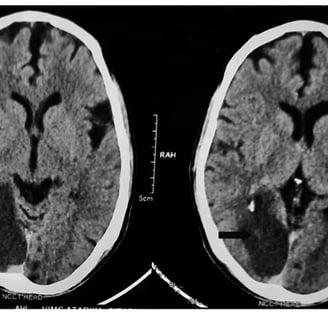Anton-Babinski Syndrome: A Comprehensive Overview
Anton-Babinski Syndrome (ABS) is a rare and fascinating neurological condition marked by a puzzling combination of cortical blindness and a strong belief that vision is intact. This denial of blindness, known as anosognosia, makes the condition as intriguing as it is challenging to understand. Despite its rarity, ABS provides a unique window into the brain’s complex relationship between vision and self-awareness.
NEUROLOGY
Rishwin A R
12/24/20242 min read


Image Credit: Adapted from National Center for Biotechnology Information (NCBI) . All rights reserved to the original authors.
Introduction
Imagine losing your vision but firmly believing you can still see. That’s the reality for individuals with Anton-Babinski Syndrome. People with ABS often create detailed, though inaccurate, explanations for their visual limitations, adding another layer of complexity to this condition.
Causes
ABS stems from damage to the occipital lobe, the brain’s visual processing center. Several factors can lead to this damage, including:
1. Stroke
Strokes, particularly those affecting the posterior cerebral artery, are a leading cause of ABS.
2. Traumatic Brain Injury (TBI)
Severe head injuries can impair the visual cortex, leading to cortical blindness.
3. Tumors
Masses in the occipital lobe can disrupt normal brain function and cause blindness.
4. Infections
In rare cases, infections like encephalitis can damage the occipital region and trigger ABS.
5. Neurodegenerative Disorders
Conditions like Alzheimer’s disease may play a role, though this is uncommon.
Symptoms
The symptoms of Anton-Babinski Syndrome are distinctive and often surprising:
1. Cortical Blindness
This complete loss of vision is caused by damage to the visual centers in the brain.
2. Anosognosia
Despite being blind, individuals with ABS insist they can see and may become frustrated when challenged.
3. Confabulation
Patients often fabricate detailed stories to explain why they can’t respond to visual stimuli.
4. Behavioral Changes
Denial of blindness can lead to irritability, confusion, or even anger when their claims are questioned.
Diagnosis
Identifying ABS requires careful observation and testing. Key diagnostic tools include:
1. Neuroimaging
MRI or CT scans reveal damage to the occipital lobe.
2. Visual Field Testing
These tests confirm the presence of cortical blindness.
3. Cognitive Assessments
Evaluations help gauge the extent of anosognosia and confabulation.
4. Medical History
Understanding events like strokes or injuries can provide vital clues.
Treatment
Although there’s no specific cure for ABS, several approaches can help manage the condition and improve quality of life:
1. Rehabilitation Therapy
Occupational and physical therapies can teach patients how to navigate their environment safely.
2. Psychological Support
Counselling can help patients and families cope with the emotional impact of the condition.
3. Medical Treatment
Treating the underlying cause, such as using anticoagulants for strokes, is crucial.
4. Assistive Devices
Technologies like screen readers and audio navigation tools can enhance independence.
Prognosis
The outlook for individuals with ABS varies widely. While some patients may see improvements if the underlying cause is addressed, others may experience persistent anosognosia. Early diagnosis and intervention often make a significant difference in managing the condition effectively.
Conclusion
Anton-Babinski Syndrome offers a remarkable insight into how the brain interprets and denies reality. Despite its challenges, understanding and managing ABS is possible with the right support and interventions. By focusing on the underlying causes and providing practical tools for patients, we can improve their quality of life and deepen our knowledge of the human brain.
FAQs
1. What causes Anton-Babinski Syndrome?
ABS is caused by damage to the occipital lobe, often due to stroke, trauma, tumors, or infections.
2. How is Anton-Babinski Syndrome diagnosed?
It is diagnosed using neuroimaging, visual field testing, and cognitive assessments.
3. Can Anton-Babinski Syndrome be cured?
There is no specific cure, but treatment focuses on managing underlying causes and improving quality of life.
4. What are the main symptoms of ABS?
Symptoms include cortical blindness, denial of blindness (anosognosia), and confabulation.
5. Is Anton-Babinski Syndrome common?
No, it is an exceedingly rare neurological condition.
Syndromes.xyz
Explore medical syndromes and their details here.
For Educational purposes only
The information on this site is not in any way, replacement for professional advice. Always consult your physician regarding personal queries
Connect
Support
syndromesxyz@gmail.com
© 2024. All rights reserved.
